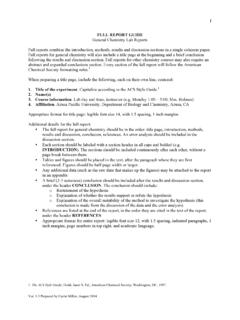Transcription of FULL REPORT GUIDE - Azusa Pacific University
1 Ver. Prepared by Carrie Miller, August 2014 1 FULL REPORT GUIDE General Chemistry Lab Reports Full reports combine the introduction, methods, results and discussion sections in a single coherent paper. Full reports for general chemistry will also include a title page at the beginning and a brief conclusion following the results and discussion section. Full reports for other chemistry courses may also require an abstract and expanded conclusions section. Every section of the full REPORT will follow the American Chemical Society formatting When preparing a title page, include the following, each on their own line, centered: 1. Title of the experiment. Capitalize according to the ACS Style 2. Name(s). 3. Course information. Lab day and time, instructor ( Monday 1:00 5:00, Mrs.)
2 Holmes) 4. Affiliation. Azusa Pacific University , Department of Biology and Chemistry, Azusa , CA Appropriate format for title page: legible font size 14, with spacing, 1 inch margins Additional details for the full REPORT : The full REPORT for general chemistry should be in the order: title page, introduction, methods, results and discussion, conclusion, references. An error analysis should be included in the discussion section. Each section should be labeled with a section header in all caps and bolded ( INTRODUCTION). The sections should be included continuously after each other, without a page break between them. Tables and figures should be placed in the text, after the paragraph where they are first referenced. Figures should be half-page width or larger.
3 Any additional data (such as the raw data that makes up the figures) may be attached to the REPORT in an appendix A brief (2-3 sentences) conclusion should be included after the results and discussion section, under the header CONCLUSION. The conclusion should include: o Restatement of the hypothesis o Explanation of whether the results support or refute the hypothesis o Explanation of the overall suitability of the method to investigate the hypothesis (this conclusion is made from the discussion of the data and the error analysis) References are listed at the end of the REPORT , in the order they are cited in the text of the REPORT , under the header REFERENCES Appropriate format for entire REPORT : legible font size 12, with spacing, indented paragraphs, 1 inch margins, page numbers in top right, and academic language.
4 1. The ACS Style GUIDE ; Dodd, Janet S. Ed.; American Chemical Society; Washington, DC, 1997. Ver. Prepared by Carrie Miller, August 2014 2 Sample Full REPORT for Spectrophotometric Analysis of Aspirin Spectrophotometric Analysis of Aspirin Carrie Miller Monday 1:00 5:00, Mrs. Holmes Azusa Pacific University , Department of Biology and Chemistry, Azusa , CA Ver. Prepared by Carrie Miller, August 2014 3 INTRODUCTION Commercial pain relievers containing acetylsalicylic acid (the active ingredient in aspirin) were used regularly by 43 million adults in the United States in 2010, an increase of 57% from Given the ubiquity of these pain relievers, it is important that the amount of acetylsalicylic acid in pain reliever tablets match the amount given by the manufacturer.
5 The purpose of this experiment is to determine the mass of acetylsalicylic acid in a commercial aspirin tablet. Because drug manufacturing is overseen by the Food and Drug Administration in the United States, it is hypothesized that the amount of acetylsalicylic acid measured will be within 5% of the amount given on the label. The mass of acetylsalicylic acid present in the tablets was determined using spectrophotometric analysis. Because acetylsalicylic acid is colorless, it was hydrolyzed to form salicylate, which in turn was reacted with the chromophoric reagent Fe(H2O)63+ to form the A chromophore is a colored compound that absorbs light with a certain wavelength. Because acetylsalicylic acid and the chromophore have a one to one molar ratio, the amount of chromophore detected is directly proportional to the amount of acetylsalicylic acid present.
6 A calibration curve was generated from a standard solution of acetylsalicylic acid. This curve was fit with Beer s Law, A = lc (1) where A is the absorbance (arbitrary units), is the molar absorptivity (concentration/cm), l is the path length of the cuvette (cm), and c is the concentration of the iron(III)salicylate chromophore. Beer s Law is the theory that connects the absorbance of light by a colored solution with the concentration of the chromophore. METHODS Part A: Beer s Law A calibration curve for acetylsalicylic acid (ASA) was generated using a Barnstead Turner SP-350 Plus spectrophotometer. A g sample of ASA was hydrolyzed by heating it in mL of a M NaOH solution. In order to develop the iron(III) salicylate chromophore complex, five samples of the hydrolyzed ASA solution ( mL, mL, mL, mL, and mL, respectively) were diluted to 25 mL in M iron(III) chloride.
7 The absorbance and transmittance of the five solutions were measured at 530 nm. Ver. Prepared by Carrie Miller, August 2014 4 Part B: Analysis of aspirin in a commercial pain reliever The mass of ASA in commercial pain reliever tablets was determined using spectrophotomeric analysis. Two tablets (from the same container) were separately ground by hand and each hydrolyzed by heating in 10 mL of M NaOH. For each tablet, mL and mL of the hydrolyzed compound solution were diluted to 25 mL in M iron(III) chloride. The absorbance and transmittance of the solutions were measured at 530 nm. RESULTS AND DISCUSSION The molar absorptivity of acetylsalicylic acid, as determined by a linear fit of the calibration curve date in Figure 1, is L/mg*cm.
8 The large R2 value ( ) shows that the data used to generate the calibration curve is very linear, and is therefore well described by Beer s law. The calibration curve was used to determine the concentration (and thus mass) of acetylsalicylic acid in two tablets, diluted to two different concentrations (Table 1). The two tablets analyzed were only 1% different in mass, but had an average of 8% difference in the mass of acetylsalicylic acid present. The average mass of acetylsalicylic acid in the tablets is 317 mg. The mass of acetylsalicylic acid listed on an aspirin bottle is 325 mg, giving a small difference ( ) between the measured value and the amount given on the bottle. Because this percent difference is less than 5%, the two numbers are considered to be in good agreement with each other.
9 Table 1. Physical and spectroscopic properties of aspirin tablets Quantity Tablet 1 Tablet 2 Mass of tablet (g) Absorbance, mL dilution Transmittance, mL dilution Absorbance, mL dilution Transmittance, mL dilution Mass acetylsalicylic acid, mL dilution (mg) 346 303 Ver. Prepared by Carrie Miller, August 2014 5 Table 1. Physical and spectroscopic properties of aspirin tablets Quantity Tablet 1 Tablet 2 Mass acetylsalicylic acid, mL dilution (mg) 314 304 Figure 1. Beer s Law calibration curve for the absorbance of 530 nm light by acetylsalicylic acid. The experimental design includes method errors that affect the average mass of aspirin determined to be in the tablets. First, only two tablets were used to for the trials.
10 This small sample size increases the possibility of indeterminate errors affecting the results. To reduce this error, additional tablets would need to be tested. Second, both the hydrolysis reaction of acetylsalicylic acid with sodium hydroxide and the reaction of salicylic acid with iron(III) are assumed to proceed to completion. This assumption is reasonable because the NaOH and iron(III) solutions were present in excess compared to the molar amount of acetylsalicylic acid. If the reactions did not proceed to completion, however, the amount of acetylsalicylic acid present in the tablet would be underestimated by this technique. The direction of error caused by incomplete reactions is consistent with the result of a lower measured value of acetylsalicylic acid compared to the value on the bottle.













